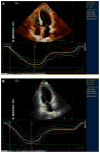Left atrial minimum volume and reservoir function as correlates of left ventricular diastolic function: impact of left ventricular systolic function
- PMID: 22543839
- PMCID: PMC3392716
- DOI: 10.1136/heartjnl-2011-301388
Left atrial minimum volume and reservoir function as correlates of left ventricular diastolic function: impact of left ventricular systolic function
Abstract
Objective: Left atrial (LA) maximum volume (LAV(max)) is an indicator of left ventricular (LV) diastolic function. However, LAV(max) is also influenced by systolic events, whereas the LA minimum volume (LAV(min)) is directly exposed to LV pressure. The authors hypothesised that LAV(min) may be a better correlate of LV diastolic function than LAV(max).
Design: Cross-sectional.
Setting: University hospital.
Patients: 357 participants from a community-based cohort study.
Methods: LA volumes and reservoir function, measured as total LA emptying volume (LAEV) and LA emptying fraction (LAEF), were assessed by real-time three-dimensional echocardiography. LV diastolic function was assessed by trans-mitral early (E) and late (A) Doppler velocities and mitral early diastolic velocity by tissue-Doppler (e'). LV systolic function was assessed by LV ejection fraction (LVEF) and global longitudinal strain (GLS) by speckle-tracking.
Results: LAV(min) significantly increased with worsening diastolic dysfunction (p<0.001), whereas the increase in LAV(max) was less pronounced (p=0.07). LAEV and LAEF decreased with worsening diastolic dysfunction (both p<0.001). In linear regressions, LAV(min) and LAV(max) were significant predictors of E/e', with higher parameter estimates for LAV(min). In multivariate models, LAV(min) resulted strongly associated with E/e' (β=0.45, p<0.001), whereas LAV(max) was not (β=-0.16, p=0.08). LA reservoir function was better associated with GLS than LVEF. In multivariate analyses, GLS was significantly associated with LAV(max) (β=-0.15, p=0.002), LAEV (β=-0.37, p<0.001) and LAEF (β=-0.28, p<0.001) but not with LAV(min).
Conclusions: LAV(min) is a better correlate of LV diastolic function than LAV(max). The impact of LV longitudinal systolic function on LA reservoir function might explain the weaker relation between LAV(max) and LV diastolic function.
Conflict of interest statement
Figures




References
-
- Kizer JR, Bella JN, Palmieri V, et al. Left atrial diameter as an independent predictor of first clinical cardiovascular events in middle-aged and elderly adults: the Strong Heart Study (SHS) Am Heart J. 2006;151:412–18. - PubMed
-
- Tsang TS, Abhayaratna WP, Barnes ME, et al. Prediction of cardiovascular outcomes with left atrial size: is volume superior to area or diameter? J Am Coll Cardiol. 2006;47:1018–23. - PubMed
-
- Di Tullio MR, Sacco RL, Sciacca RR, et al. Left atrial size and the risk of ischemic stroke in an ethnically mixed population. Stroke. 1999;30:2019–24. - PubMed
-
- Benjamin EJ, D’Agostino RB, Belanger AJ, et al. Left atrial size and the risk of stroke and death. The Framingham Heart Study. Circulation. 1995;92:835–41. - PubMed
-
- Moller JE, Hillis GS, Oh JK, et al. Left atrial volume: a powerful predictor of survival after acute myocardial infarction. Circulation. 2003;107:2207–12. - PubMed
Publication types
MeSH terms
Grants and funding
LinkOut - more resources
Full Text Sources
Miscellaneous
